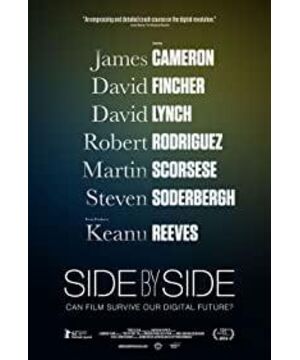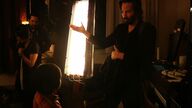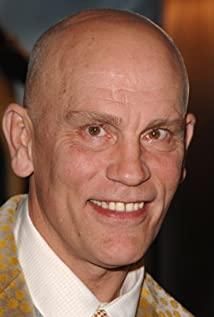Everyone has paper and pen, but how many great stories are written on that piece of paper? Now the same thing is going to happen to the movie.
--David Lynch
Recently, I have been waiting for the high-definition resources of "Quick Ready". It just so happens that Keanu Reeves's exposure rate is quite high recently, and the US media is still hanging up with a wave of awkward Keanu (probably the most popular actor in the audience. Keanu himself said he was very daunted).
I turned over some of his early works and got an unexpected gain. In addition to the "The Matrix" series, Keanu Reeves has another outstanding contribution to the film and television industry, which is the documentary I want to talk about below—— "Yin and Yang Formation."
This documentary was produced by Keanu Reeves himself as the producer and reporter. He interviewed a large number of leading industry guides and photographers to discuss the film and digital disputes under the current (2012) film system.
Under close investigation, the whole film exudes a regular essay atmosphere. It disassembles the existing film and digital contradictions, and discusses the capture, development, projection, and storage of dynamic images. The famous guides explained their feelings, interspersed with basic theoretical knowledge and the development history of related technologies.
In fact, this movie is not as cold and obscure as the description. Although it is not to gather the directors together to have a Huashan discussion, the views of the directors in each link are different, and the seamless editing has formed a cross-space. Debate battle.
There is no too radical and trendy viewpoints. The digital dispute on film is also a common topic in the popular context. Everyone understands that the wave of digitalization is unstoppable, but just like the Chinese translation of Yin and Yang, all the elements finally converge and integrate. The discussion on the technical and artistic hybrid of film, which contains the endless fun of fascinating people.
First, let’s briefly list the famous directors who appeared on the film. There is no way to list them all. There are detailed subtitles and annotations in the film. You can see the title "Yin and Yang" at station b: George Lucas, David Finch , Robert Rodriguez, Christopher Nolan, Martin Scorsese, James Cameron, David Lynch, Joe Schumacher, Lars von Trier, Danny Boy Er, Lana/Andy Wachowski, Steven Soderbergh...
First of all, if there is not a big star like Keanu Reeves to be a producer, "Yin and Yang" is absolutely impossible to be born, I must solemnly thank Keanu for the decision that took half a second. Ideas.
The top artists and technical madmen in the lens are actually very simple and pure, and their views and positions are highly consistent with their own works: David Finch, who is full of Funk, and sister Wachowski who is rich in philosophy. Brother (now a sister), Danny Boyle who can get up anytime and anywhere, and the cute old horse...
In Giotto Canudu's "The Seventh Art Manifesto", he called film a synthesis of the first six art forms, a new art with temporal and spatial attributes.
But today we are used to using a term: the film industry, in fact, it is unique, and there has never been an art form that can really be linked to industry. Except for the clichés of "teamwork" and "high cost", movies have always been a mixture and symbiosis of art and technology.
I don’t make any judgments about which one is more important, but I believe that it is this hybrid attribute that makes film an independent art, and technology is the first driving force for the development of film, the continuous updating of human technology, and the film industry. Its extremely high conversion rate makes the movie an ascendant existence in the eyes of every generation.
"Yin and Yang" provides us with an idea. The transition of the film industry from film to the digital age is not only due to lower cost and easier operation. The root of this change actually comes from people's desire to control this art. This desire is often Technical support is needed, and the refurbished technology has turned over to refresh people's desires.
To give a simple example, the vast majority of early film editors (called editors or mechanics at the time) were mostly women, because this type of work was similar to women weaving, only cutting and pasting films, and the director rarely walked into the editing room. Later, in order to meet the needs of the senses, there were sound films and color films. The great richness of audiovisual elements made the film need to be edited between each frame. The importance of editing became prominent, and it gradually gained the title of editor.
The digitization of movies comes from a higher degree of freedom editing mode. The smallest unit of editing is no longer a frame, but can be finely edited on each frame.
Digital editing can handle richer pictures. It can adjust every parameter of every part of the picture at will, and gradually replace the traditional photochemical color matching.
Correspondingly, more convenient and reliable digital shooting equipment has become an urgent need for people. Videos shot with handheld DV began to win awards at the Sundance Independent Film Festival and achieved good box office results. Manufacturers continue to overcome the problems of clarity and tolerance, but its progress has been relatively slow.
After digital equipment and editors intervened in the creation of the film, the photographers were the first to be affected. The captured images no longer need to be printed overnight to be seen. Everyone can see the captured images in real time through the monitor, and the film is finally The rendering effect is also more controlled by digital colorists. Photographers in the film age are the only people who can know the effect of the next day's sample. This is a romantic power. They can proudly say to the director "Let's see tomorrow, it must be super pleasant." Of course, there are many "What the funk!" The fright, David Fincher added.
In the digital age, everyone can see the images, and the professionalism of photographers is often questioned. Many people have the illusion that "I can do it with the machine".
The digital camera has brought earth-shaking changes to the entire shooting work. It greatly expands the shooting time of a single camera. You don't need to shoot more than ten minutes to replace it with a new box of film. The convenience of the volume also provides more camera positions. The possibility of shooting, more information can be captured in one shot, and the choice of lens is more flexible.
With the "unlimited NG" technical possibility (the actor's nightmare) in the filming, without the cost limit of the film, one can continue to take another one if one is not satisfied.
When it comes to the downstream links of film screening and storage, it is no longer necessary for the director to stand up and discuss it. The reality can tell everything: there are fewer and fewer theaters with film screening conditions, and the vast majority of films have been fully digitized.
Although the timeliness of digital storage is very poor, Martin Scorsese also mentioned that film may be the only medium that can be stored for 60 to 70 years, but this method has no commercial nature and has become a means of collection. .
So at the end of the film, Nolan became the only director who insisted on filming, and insisted on shooting his films only on film.
At the end of almost every point of view, Nolan came out to sing the opposite. The "film school" in the entire "debate" always talked about abstract words such as "art" and "texture", and faced those who could speak rigorously. The “digital faction” obviously lacks credibility.
In today's network environment, this group of people are just "extraordinaires" who are ignorant of current affairs, and Nolan is still the most boring "extraordinary master", and most of the time, they have to take advantage of the situation.
In fact, "Yin and Yang" is not for everyone to argue about the pros and cons of film and digital, and it is not a battle between the survival and death of the two. It is about to 2020. If there is really any unique foresight in the film, A few years after the film is completed, it is meaningless. Reality is always more convincing than anything.
Just talk about the domestic situation: the movie "Yangtze River" released in 2016 claimed to be China's last film film ("Dog Thirteen" and "Wuwen Xidong", which were postponed for many years, were also filmed on film). This is because the film was cleaned the day before the Beijing Film Processing Factory was dismantled. Since then, it has been almost impossible to complete the film processing in China.
2007 was recognized as the pinnacle of film in the industry. The decline of film under the technological wave is staggering. It seems that overnight everyone has asked why film is used for filming. Twenty years later, will anyone still mention film?
The purpose of "Yin and Yang" is actually very simple. It is just a film where Keanu Reeves wants to record the status quo of the industry in the context of a renewal.
The question he uses the most is "Where are we today?" . All interviews and surveys in the film are to answer this question. No one in the director can answer this question, not even Cameron, who is at the forefront of technology. Give the answer.
But the direction of the celebrity directors' thinking is surprisingly consistent, and they all point to the film itself.
Everything is suddenly clear at the end. Both the "film school" and the "digital school" are filmmakers who use technology. Although they have different tools, they are also comrades in the trenches. Naturally, there is no such thing as leverage. They reflect on it. The focus is on what technology can bring to the film and take away.
In other words, does the speed of film quality improvement really keep up with the speed of technological renovation? Have we really produced more good works?
So I chose David Lynch’s words at the beginning. I think this sentence can also provide an outline for the "movie essay" of "Yin and Yang": Everyone has paper and pen, but on that piece of paper How many great stories have you written?
At this time, the "film school" viewpoint has a lot of weight. Although the work of film and film is complicated, it also teaches people principles. People in the digital age have forgotten, and more and more people will no longer care about taste. .
David Fincher shared an anecdote about Downey. In order to protest the crew's uninterrupted filming for more than ten hours a day, he took the potty to the studio to protest.
No limit is not entirely a good thing. Once the film machine is turned on, it means that the cost starts to be consumed. The crew members must take the best state to start shooting. You can take a break and adjust the state in two or three minutes between film changes. On the contrary, there is no After the shooting time is limited, people's shooting efficiency has not improved significantly.
The vast majority of directors who support film are not indifferent to the past, they just think that the lawfulness and focus brought by film shooting are more suitable for them.
Imagine that the first Chinese martial arts film "Xia Nv" to stand on the world stage reached the highest artistic achievement in Chinese martial arts film (nominated in the main competition unit of Cannes). At that time, Hu Jinquan could not even follow the fast mirror movement. Now it is a scene. We can get more than a dozen angles of material, but we have never surpassed the achievements of our predecessors, and even qualified martial arts movies and action movies are not common.
It should be our more powerful information processing ability that matches the amount of information that the device can obtain.
The functional nature of movies to show and restore material reality has never changed, but we actually get worse and worse.
Nolan’s words are actually quite pertinent. Why do people keep asking me why I use film instead of asking why others use numbers? (The implication is that whoever loves to use numbers, I don’t use it anyway, Tsundere)
The value of film retention nowadays is that it is still a reliable choice. Although digitalization is a trend, it is by no means a panacea. No matter what method is used, it must eventually fit the film. The 3d used by Cameron is the same as the current flood of post-transformation 3d. What is the difference between blockbusters? I believe that every viewer has a scale in his heart.
After the production of the film was completed in 2014, Martin joined Nolan, Quentin and other directors to initiate a proposal to defend the film. Several major Hollywood studios signed an agreement with Kodak, which had just passed the bankruptcy protection period, to purchase a certain amount from Kodak every year. film.
I was very touched by a sentence that Johnny To once said:
"I don't think Hong Kong movies are dead, even if we only produce one movie every year, it is also a Hong Kong movie."
If there are directors who are still willing to use film as the form of their own films, then it should always exist as a choice. I hope that in the future, Nolan is still willing to stick to film. Cameron and Rodriguez are still fighting at the forefront of technology. None of them can persuade anyone, and they don’t have to persuade each other. That is the real "yin and yang". .
The civilianization of shooting equipment has made the art of film startling, but digital imaging or digital technology has never changed the way humans tell stories. A good film always takes us to see the world with humanistic care. As for how to look and where to look, Let's first look at the problem that directors have been thinking about how to change for hundreds of years.
It’s almost 2020. People in the last century watched the animated version of "The Lion King" in movie theaters. Now we watch the 3D version of "The Lion King" in movie theaters. Will we still see the VR version at home in 30 years? "The Lion King"? The technology has undergone earth-shaking changes, but why is the world in our eyes so similar?
After decades, we are still consuming the humanistic care of our predecessors. Where is the humanistic care of our generation?
I think the true meaning of "Yin and Yang" is to reveal the source of vitality of the film industry through the heartfelt words of each practitioner. The two source codes of original art and technology are the DNA of film. They are the same root, opposite and connected.
Industry rules and technical methods are always changing, and directors also have different positions and opinions, but when it comes to movies, they are reconciled with yin and yang. One thing will never change: mobilize your perception and do it with sincerity. If you do, then it doesn’t matter what method you do.
The article was first published on the public account [Little Monster World]
Welcome everyone to pay attention to this cute and loveable public account
I hope the excellent you will be safe and happy in your life
View more about Side by Side reviews











